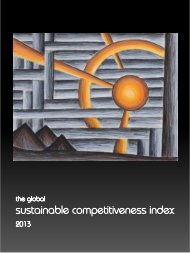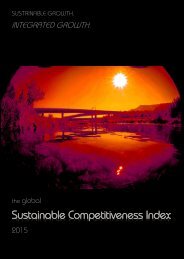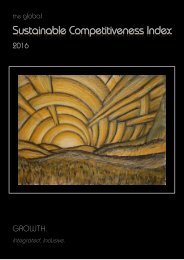The Global Sustainable Competitiveness Index 2019
Measuring competitiveness comprehensively: Sweden & Scandinavia tops, Germany #15, UK 17, US 34, China 37 in the Global Sustainable COmpetitiveness Index 2019
Measuring competitiveness comprehensively:
Sweden & Scandinavia tops, Germany #15, UK 17, US 34, China 37 in the Global Sustainable COmpetitiveness Index 2019
You also want an ePaper? Increase the reach of your titles
YUMPU automatically turns print PDFs into web optimized ePapers that Google loves.
Methodology
Table of
Contents
8.3 Index calculation
The raw data consist of numerical values. While values can be
ranked against each other, they cannot be compared or
added to other values (two apples plus three oranges are not
equal to five pineapples). It is therefore necessary to extract a
scalable and comparable score from the raw data as a first
step.
When comparing raw data of variables of different countries,
an “absolute best” cannot be defined. Scores therefore
cannot be calculated against a real or calculated best score.
For the purpose of this index, the raw data was analysed and
ranked for each indicator individually. Trough calculation of
the average deviation, the best performing 5% receive the highest score (100),
and the lowest 5% receive the lowest possible score (0). Scores between the
highest and the lowest 5% are linearly assigned relative to the best 5% and the
worst 5%.
Calculating scores from raw
data
In a second step, the relative importance (weight) of the
indicator is assessed against other indicators to calculate
scores for the 5 sub-indexes. The Sustainable Competitiveness
Index is calculated based on the sub-indexes, each weighted
equally.
Data in perspective
Raw data has to be analysed in perspective: 5000 ha of forest
might be a large area for a country like Andorra, but it is a small
area in China. Depending on the indicator, the denominator
might be the land area, the size of the population, or intensity
measurements, e.g. GDP. For certain indicators, (e.g. energy
efficiency, but also innovation indicators), the performance is
evaluated against two denominators (normally population size and GDP) in
order to gain a more altruistic picture of the national sustainability performance
that incorporates economic and human efficiency.
Each level of the Sustainable
Competitiveness Pyramid is
equally important and
therefore equally weighted
Trend analysis: Integrating recent developments
Current data limits the perspective to a momentary picture in
time. However, the momentary status is not sufficient to gain a
true picture of the sustainable competitiveness, which is, by
definition, forward-looking. Of equal importance are therefore
the trend developments. Analysing trends and developments
allows for understanding of where a country is coming from –
and, more importantly - indicates the direction of future
developments. Increasing agricultural efficiency, for example,
indicates a country's capability to feed an increasing
population in the future, or the opposite if the trends are
decreasing. Where sufficient data series are available, the
trend was calculated for the latest 5 years available and scored to evaluate the
current level as well as the future outlook and sustainability potential of a country
based on recent developments.
In order to reflect a dynamic
performance picture,
performance trends are
analysed, scored and
integrated in the Sustainable
Competitiveness Index
40








